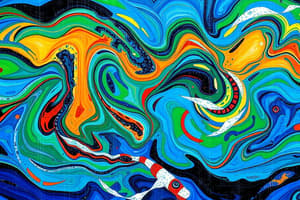Podcast
Questions and Answers
What did Captain Charles Moore discover while sailing from Hawaii to California in 1997?
What did Captain Charles Moore discover while sailing from Hawaii to California in 1997?
- A trail of breadcrumbs leading him home
- A steady stream of plastics bobbing in the ocean (correct)
- A large number of plankton floating on the ocean surface
- A deserted island made entirely of plastic waste
What did Captain Charles Moore compare the plastics he noticed to?
What did Captain Charles Moore compare the plastics he noticed to?
- A trash vortex in the ocean
- A deserted island made entirely of plastic waste
- A trail of breadcrumbs like Hansel and Gretel leading him home (correct)
- A sturdy landmass in the Pacific Ocean
What did Captain Charles Moore find using a net system to sample the surface of the ocean?
What did Captain Charles Moore find using a net system to sample the surface of the ocean?
- Plankton but no plastic floating in the ocean
- Six times as much plastic as plankton floating in the ocean (correct)
- An equal amount of plastic and plankton floating in the ocean
- The source of the litter floating in the ocean
What creates the Great Pacific Garbage Patch (GPGP)?
What creates the Great Pacific Garbage Patch (GPGP)?
How has the GPGP been depicted in the media since its discovery?
How has the GPGP been depicted in the media since its discovery?
What is the main cause of plastics being sucked into the GPGP?
What is the main cause of plastics being sucked into the GPGP?
What did Captain Charles Moore discover in 1997?
What did Captain Charles Moore discover in 1997?
Why is it difficult to capture an overview of the garbage patch?
Why is it difficult to capture an overview of the garbage patch?
What was the scale of the Great Pacific Garbage Patch predicted to be in a 2018 study?
What was the scale of the Great Pacific Garbage Patch predicted to be in a 2018 study?
What did an advertising stunt for World Oceans Day in 2017 contribute to people's perception of the garbage patch?
What did an advertising stunt for World Oceans Day in 2017 contribute to people's perception of the garbage patch?
What percentage of the estimated 1.8 trillion pieces of plastic in the Great Pacific Garbage Patch are microplastics?
What percentage of the estimated 1.8 trillion pieces of plastic in the Great Pacific Garbage Patch are microplastics?
What did the advertising stunt for World Oceans Day call on the United Nations to do?
What did the advertising stunt for World Oceans Day call on the United Nations to do?
What percentage of the total mass of garbage found in the GPGP is debris greater than 5cm in size?
What percentage of the total mass of garbage found in the GPGP is debris greater than 5cm in size?
How did people perceive the scale of the Great Pacific Garbage Patch after the 2017 advertising stunt for World Oceans Day?
How did people perceive the scale of the Great Pacific Garbage Patch after the 2017 advertising stunt for World Oceans Day?
What misconception did the advertising stunt for World Oceans Day contribute to?
What misconception did the advertising stunt for World Oceans Day contribute to?
Why do many misconceptions still exist about remote garbage patches?
Why do many misconceptions still exist about remote garbage patches?
Study Notes
The Great Pacific Garbage Patch
- In 1997, Captain Charles Moore discovered a large amount of plastic debris while sailing from Hawaii to California.
- He compared the plastics he noticed to a "plastic soup" due to their abundance and fragmentation.
- Using a net system to sample the surface of the ocean, Moore found a significant amount of small plastic pieces, including microbeads, bags, and other debris.
Formation and Size of the Great Pacific Garbage Patch
- The Great Pacific Garbage Patch (GPGP) is created by a combination of ocean currents and winds that collect and concentrate plastic debris in a specific region.
- The GPGP has been depicted in the media as a large, island-sized patch of trash, but this is a misconception.
- In reality, the GPGP is a large area of the ocean where plastic debris is highly concentrated, but not a solid island.
- The main cause of plastics being sucked into the GPGP is the North Pacific Subtropical Gyre, a system of ocean currents that collects and concentrates debris.
Perception and Misconceptions
- It is difficult to capture an overview of the garbage patch because it is dispersed over a large area and composed of small pieces of debris.
- A 2018 study predicted the scale of the Great Pacific Garbage Patch to be around 1.6 million square kilometers.
- An advertising stunt for World Oceans Day in 2017, where a "trash island" was created, contributed to people's perception of the garbage patch as a solid island.
- However, this stunt perpetuated a misconception about the nature of the GPGP.
- Many misconceptions still exist about remote garbage patches because they are difficult to visualize and study.
- In reality, the GPGP is composed of around 1.8 trillion pieces of plastic, with microplastics making up around 99% of the total count by number.
- Debris greater than 5cm in size accounts for around 25% of the total mass of garbage found in the GPGP.
Studying That Suits You
Use AI to generate personalized quizzes and flashcards to suit your learning preferences.
Description
Take this quiz to test your knowledge about the discovery of the Great Pacific Garbage Patch, a massive area in the North Pacific Ocean filled with plastic waste. Learn about Captain Charles Moore's encounter with the patch and its environmental impact.




